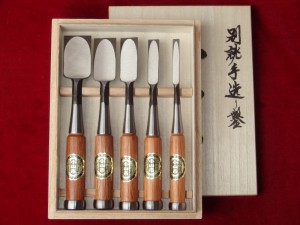 Needs Pictures: 0
Needs Pictures: 0
Results 1 to 6 of 6
Thread: Rebuilding a Kiyohisa oire nomi
-
23rd January 2021, 04:27 AM #1
 Rebuilding a Kiyohisa oire nomi
Rebuilding a Kiyohisa oire nomi
I sort of collect ... and use ... Kiyohisa chisels. I purchased a set of slicks about 12 years ago, which were a 3 year wait. I was lucky - soon after this there was a 6 year waiting list. Unfortunately, they are now no longer being made as Watanabe Kiyoei has been very ill for some time.
So Yamashita writes about Watanabe: Japan Tool - Chisels - Kiyohisa Oiire Nomi
There are better nomi than Kiyohisa, that is, blades which hold a longer edge, but using these always makes me smile.
I wanted some of the oire nomi - bench chisels - however they have become collector's tools and incredibly expensive. There are some silly prices on eBay. Not sure if they are actually sold at the asking money. I've been lucky, and managed to pick up a few - and new! - for very reasonable amounts.
A few weeks ago I purchased a 30mm oire nomi on eBay. It was going quite cheaply, mainly because it was 30 years old and used. It arrived yesterday, and I was disappointed. It had not been looked after. Yes, the blade was worn, but there is a lot of meat left, and it said to me that it was used well. It was smaller than expected, but not the issue on its own. It was the handle, now about 3/4" to 1" shorter than the original .. and this made it too small for my hand.
The advert in the auction did not represent the state of the chisel accurately. I could have sent it back, but the cost of doing so was prohibitive (what has happened to US shipping costs!!!). The Seller was really a good guy. We talked about it. In the end he refunded part of the purchase price (making it even cheaper), and I decided to renovate the chisel. Perhaps restore some of it past glory?
This is going to be one of those articles with LOTS of photos - all you wanted to know about dismantling and rebuilding an oire nomi
Here is the chisel when it arrived, alongside a 24mm Kiyohisa oire nomi (on the left), which is new ...

So ... we need to make a new handle. I have some US White Oak, which is the closest wood to the Japanese White Oak used by Watanabe among the others in my collection. That will have to do ... I can always make another handle if this does not work out.
First step is to remove the handle. These chisels are constructed with a tang and a socket. How do you get them apart? The answer is to rap the handle on a hard surface ...

Just keep tapping. It will come apart ... eventually.

Take note - the tag is square, as is the mortice ...

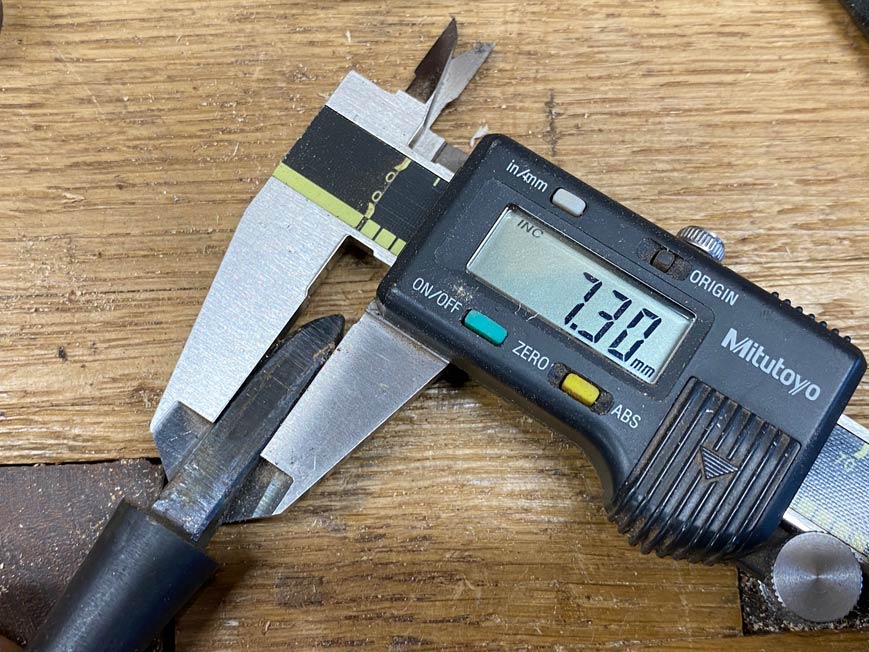
Next: remove the ferrule. It comes off the opposite way it went on! I had an idea to make a tool to do this from a short section of aluminium tube - hammered the end flat ....
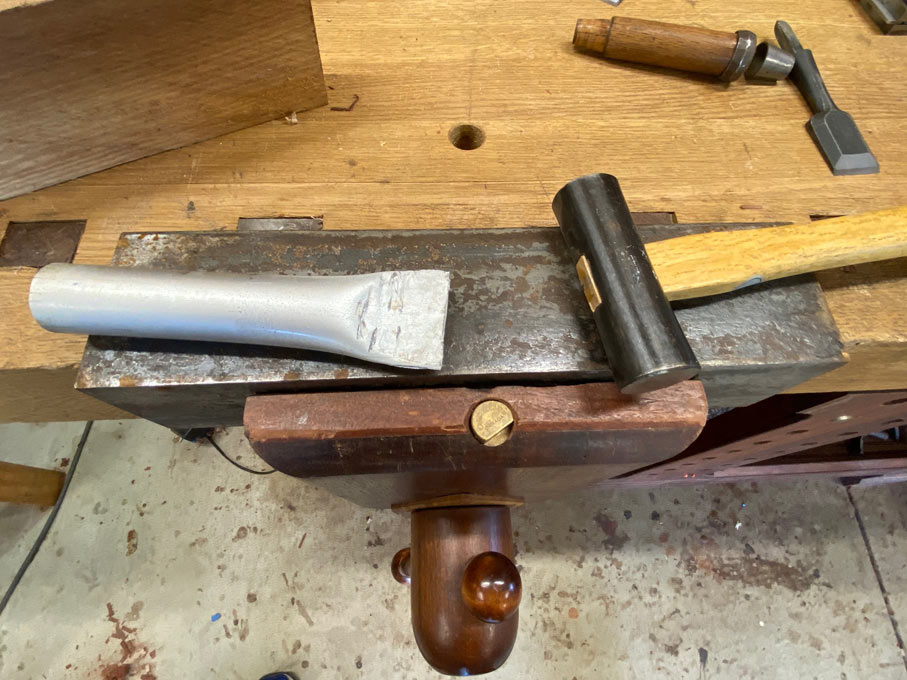
... then popped the handle inside, and tapped the end down ...
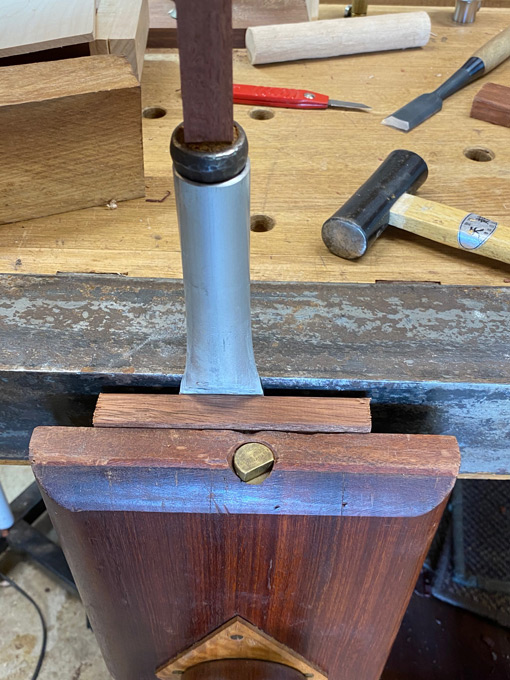
... and off came the ferrule ...
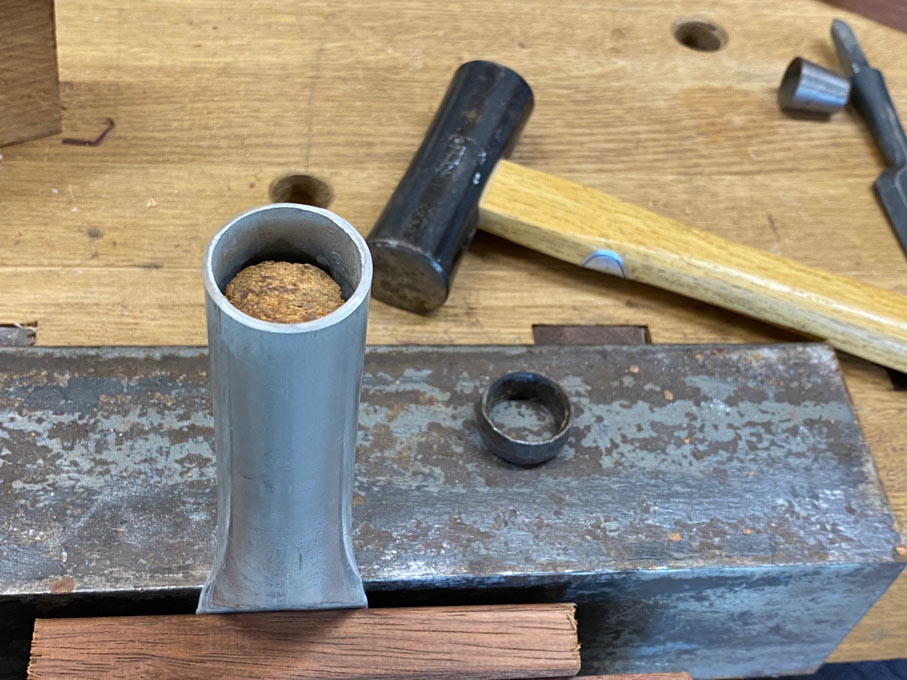
Now we go over to the lathe. The White Oak has been turned into a cylinder, and the length of the handle marked from the 24mm Kiyohisa. I have orientated the wood until the grain runs as straight as possible ...
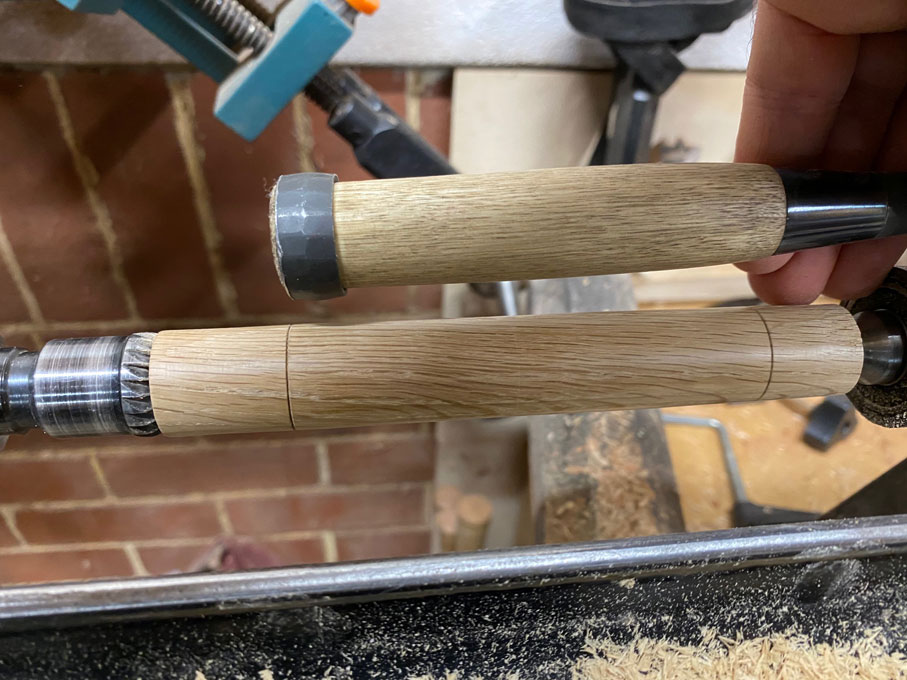
The other measurements that are needed are the diameter of the handle, and the start and end of the tenon ...
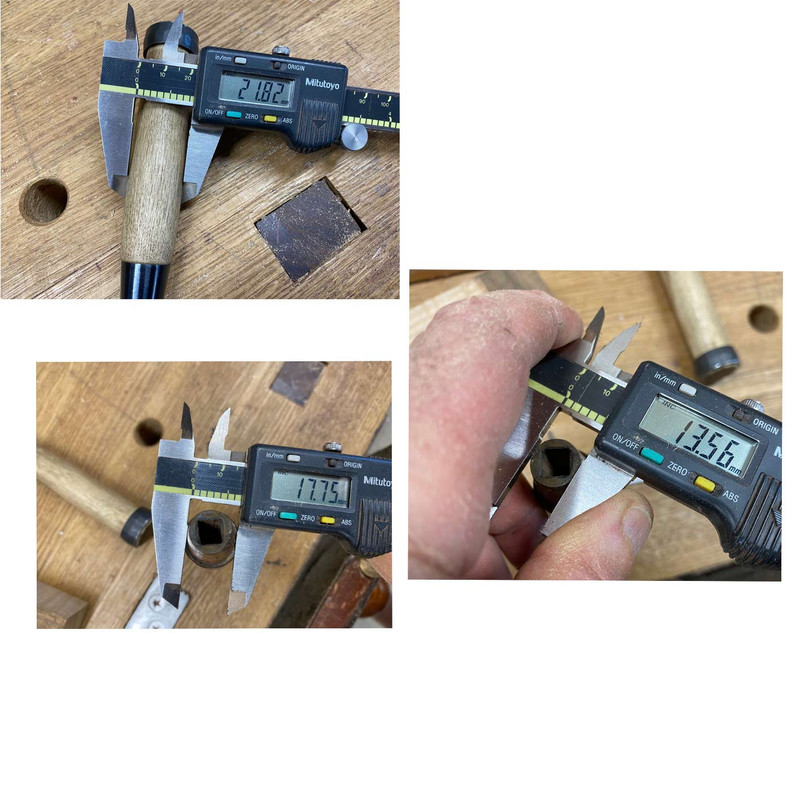
The tenon is turned from the latter measurements ...
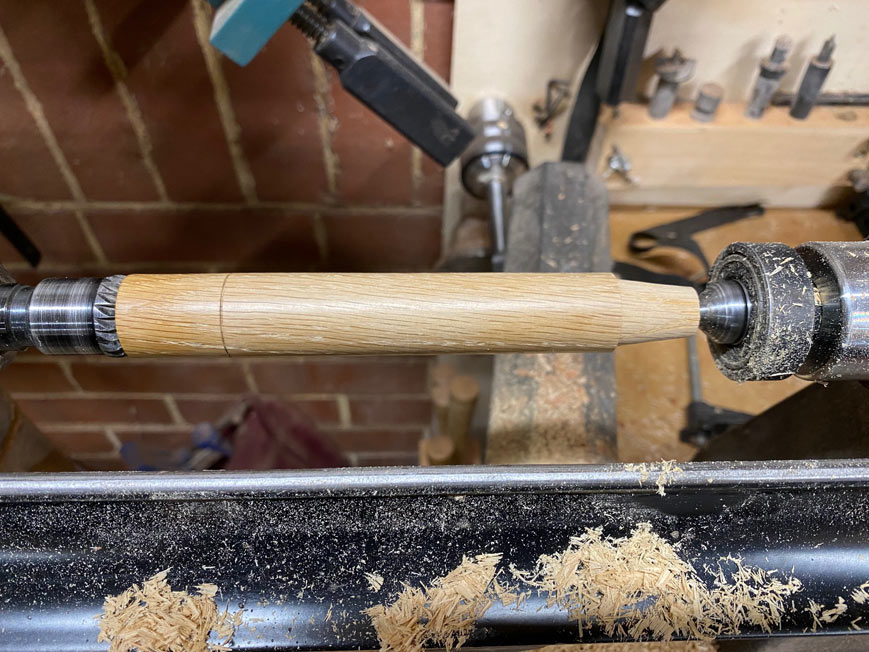
Next, clean the inside of the ferrule. It is rusty.
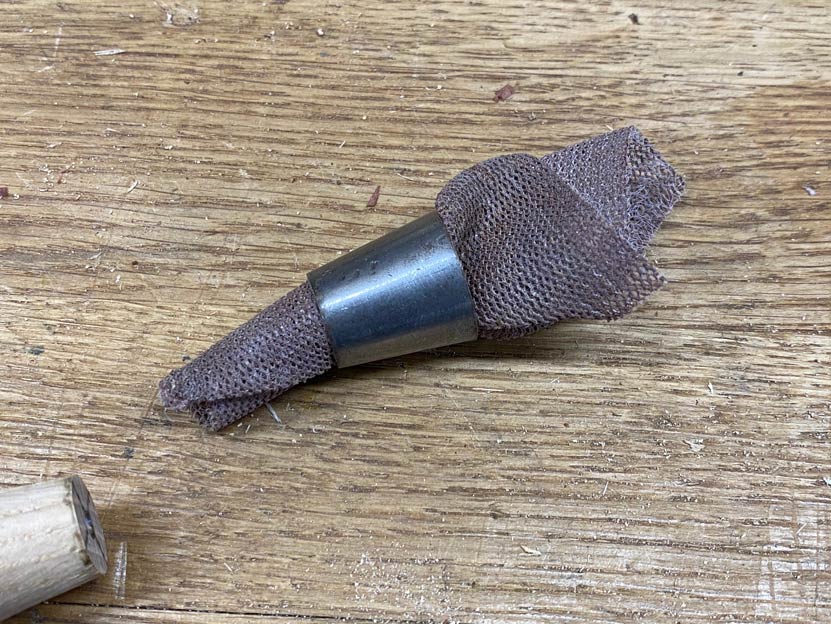
It needs to slip on firmly, and sit flush with the end of the tenon ...

Drill out most of the mortice ...
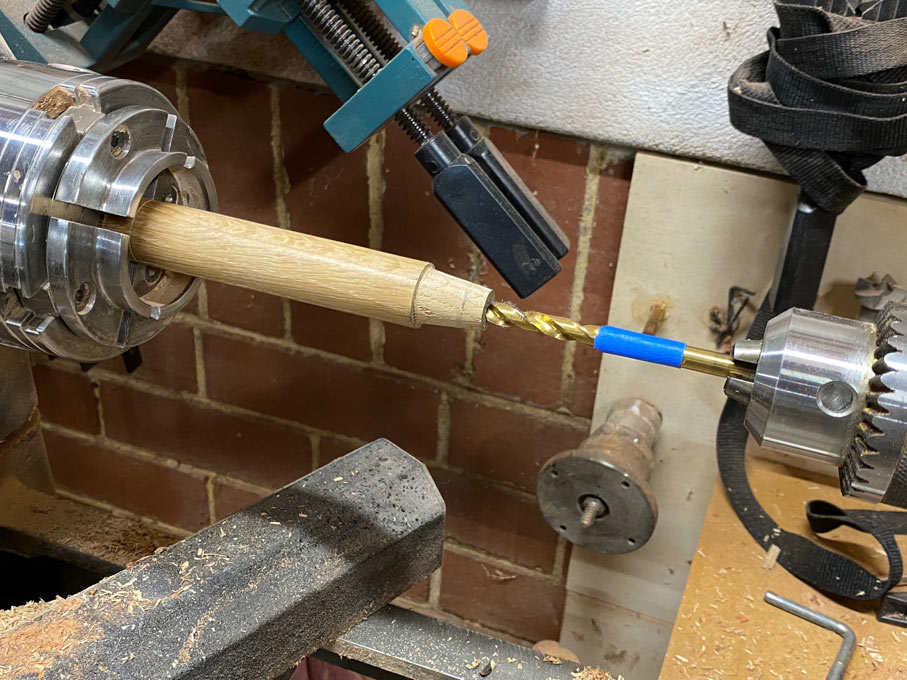
... and then mark and chisel out an exact fit for the tang ...


The fit is as good as I could hope for - a little force drives it home ...
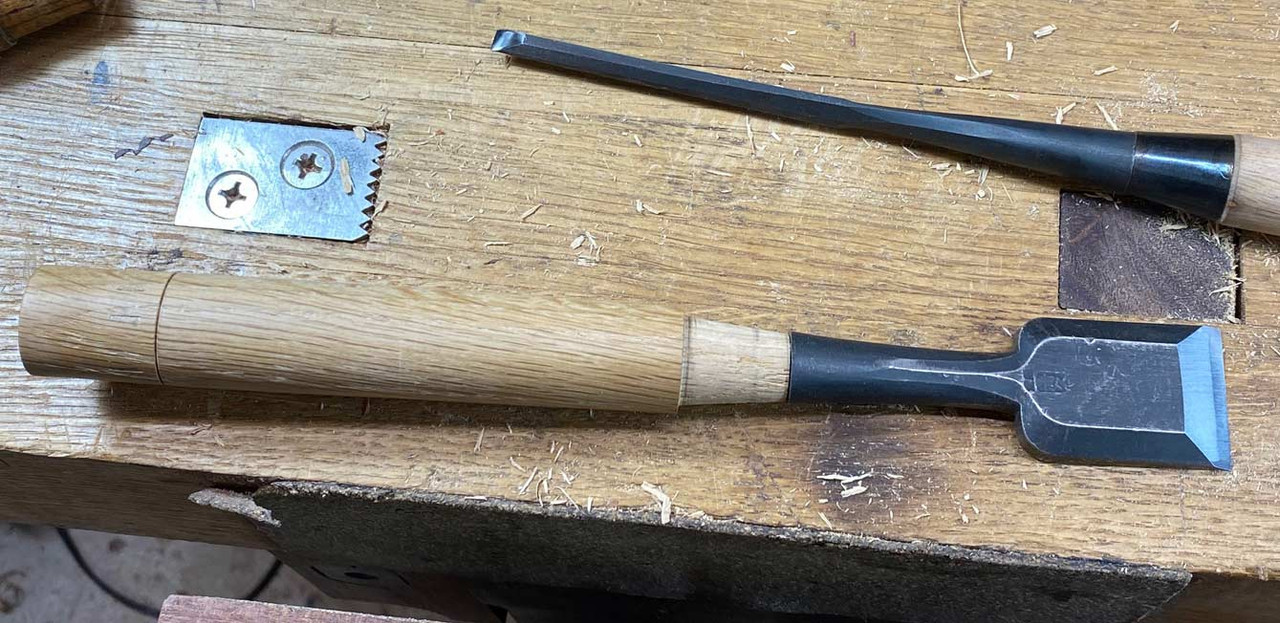
Back to the lathe to add a small chamfer to the tenon ...
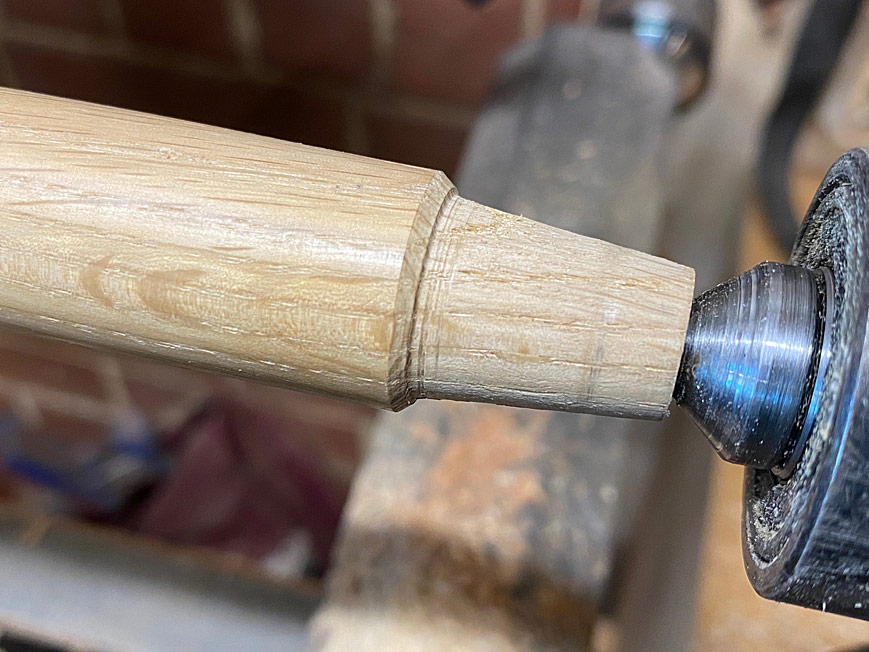
Before the handle is cut to length, some finish is added. Initially, this was just Renaissance Wax. However, later when sharpening the blade I notice that this failed to stop the wood becoming black (as the tannin in oak is apt to do around iron filings). I returned later to re-finish the handle in Ubeaut Shellawax.
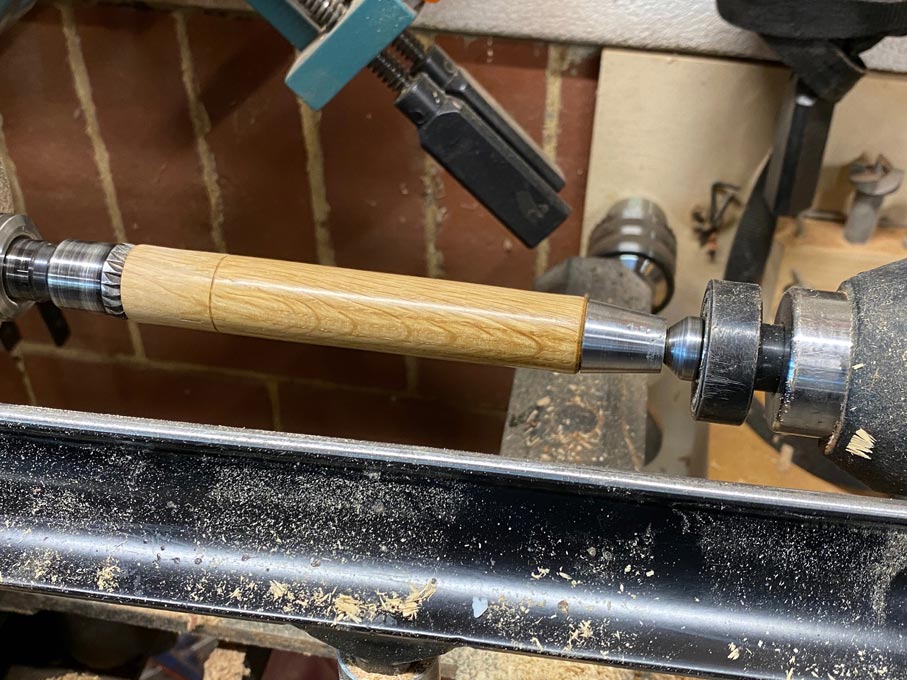
After 30 years, the ferrule has been hammered and has flat spots. These need to be removed otherwise it will not fit over the end of the handle. I used a knife to scrape the inside of the band ...
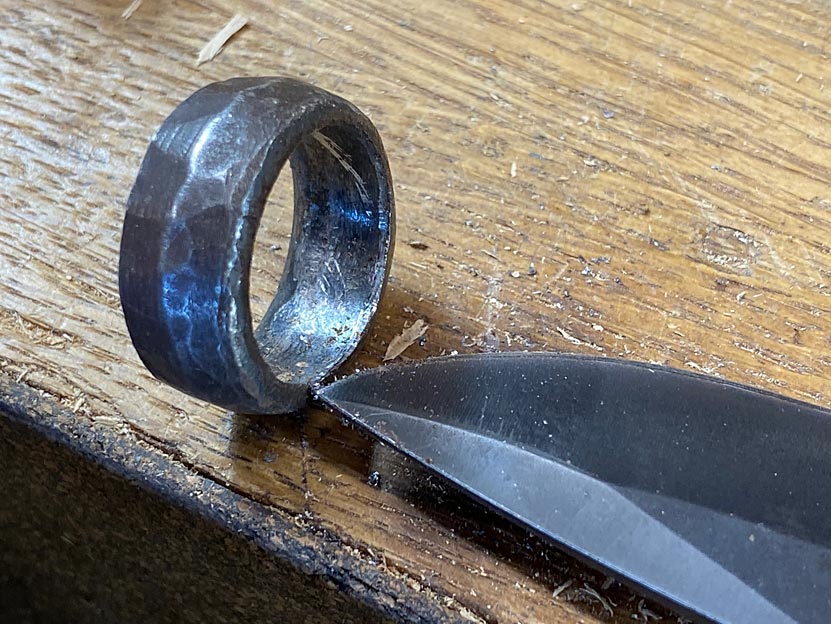
To re-fit the ferrule, the handle is marked off with about 2mm spare ...
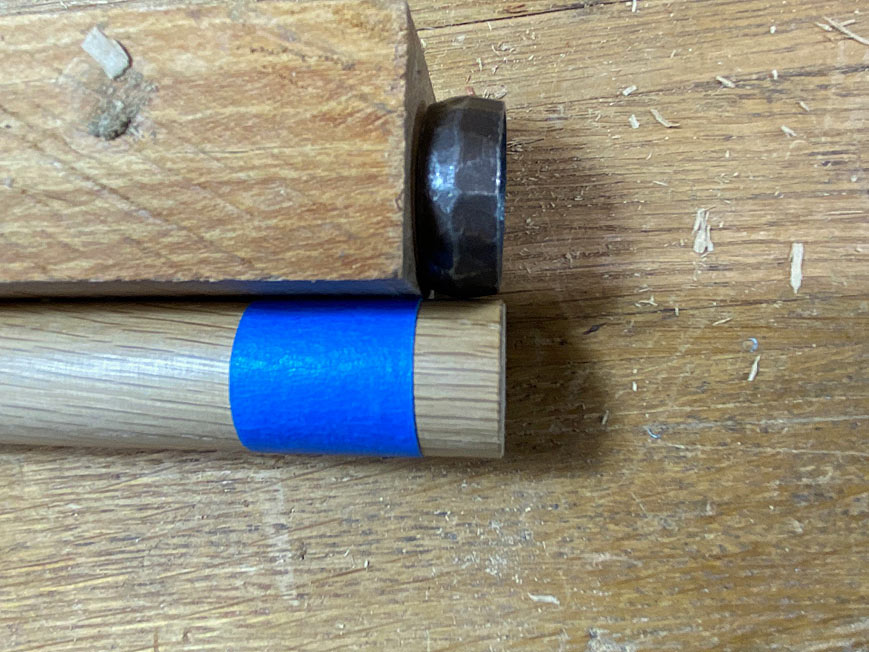
At this stage the ferrule does not fit ...
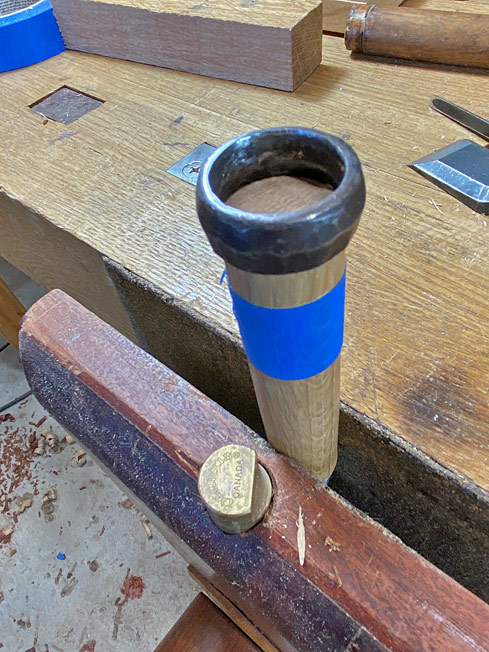
... and the end of the handle needs to be pared ...
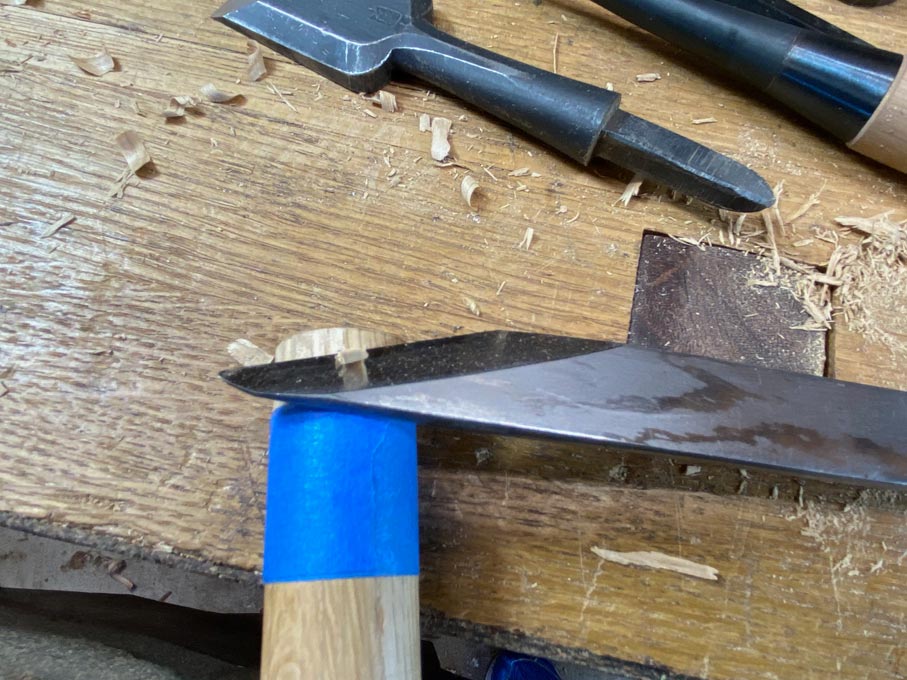
It can be hammered on until it lies flush ...
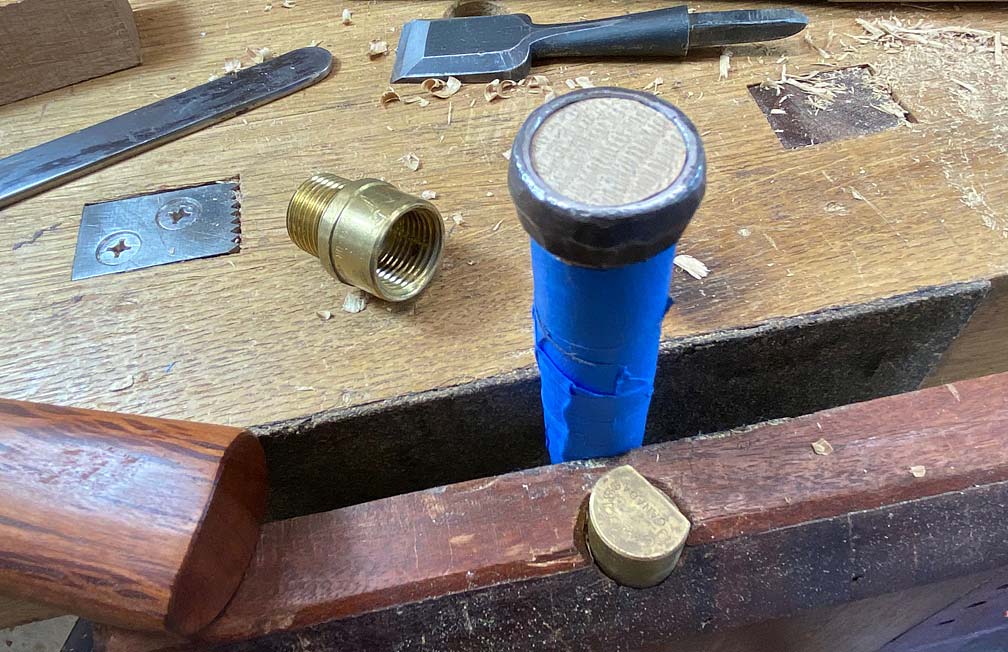
I do not own a tool for seating the ferrule. Over the years I have set the ferrules on Japanese chisels using a brass plumbing connector ...
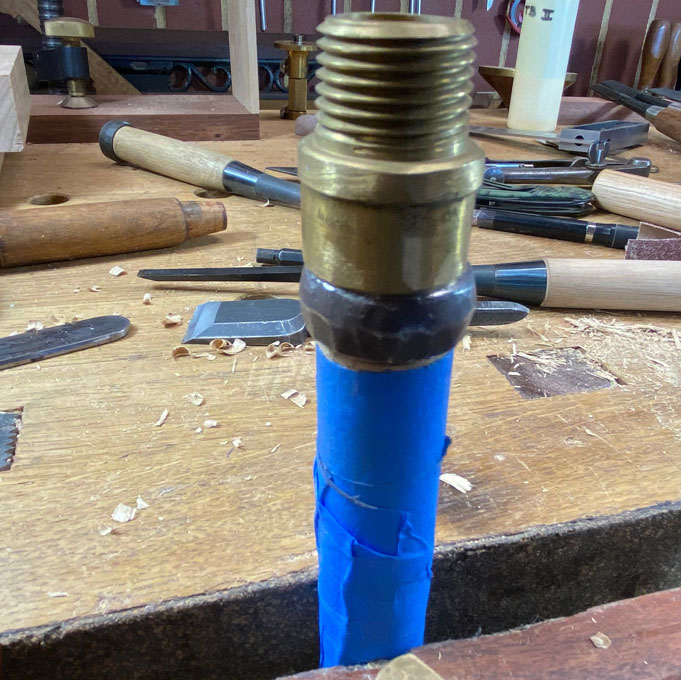
Drive the ferrule down about 2mm below the end of the handle ...
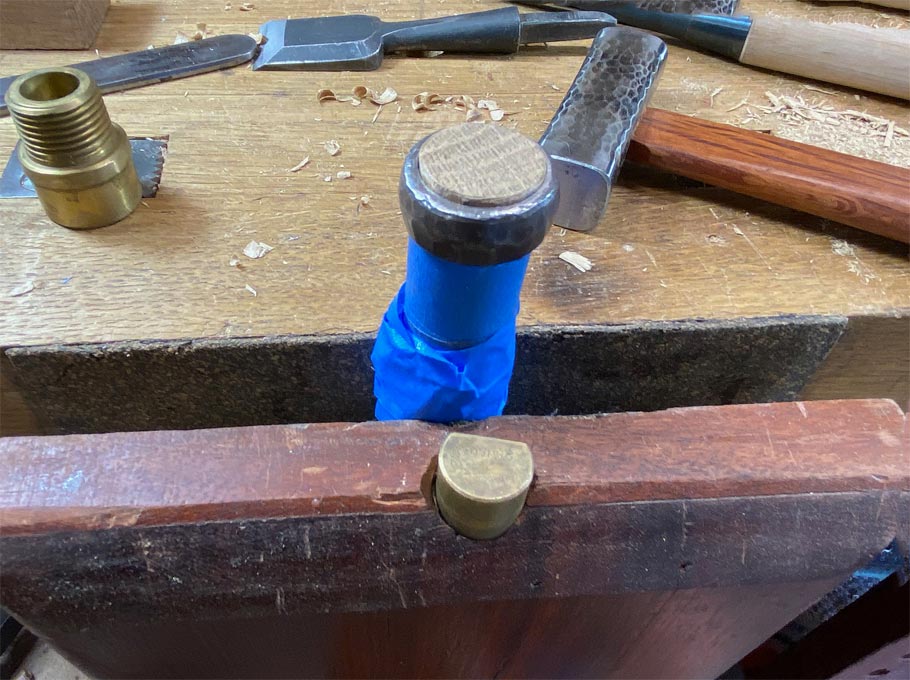
Then peen the edges of the handle over the ferrule ...
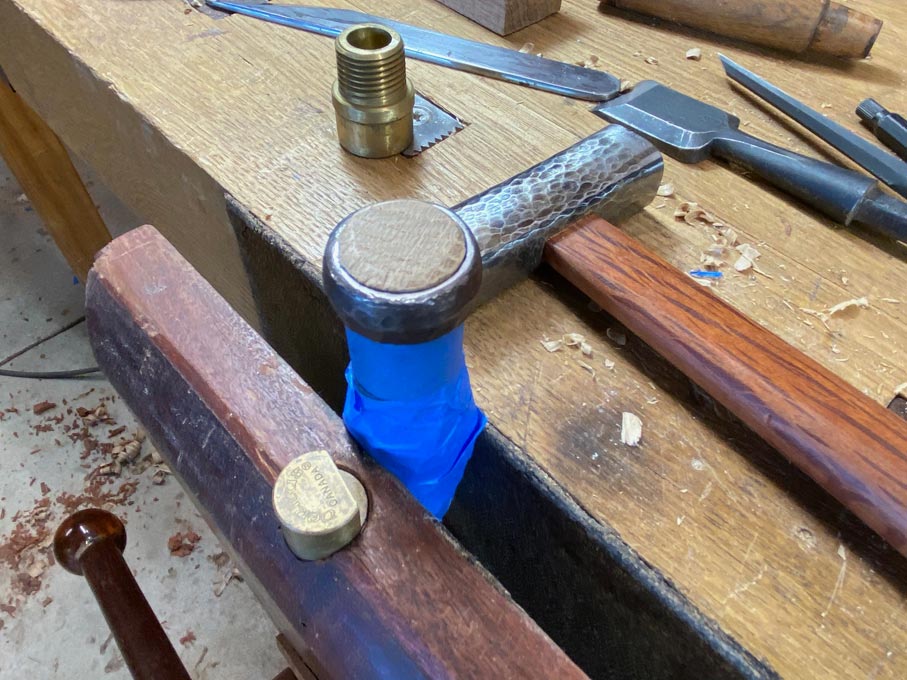
The peened ends do not extend over the ferrule - it is the handle you hit, not the ferrule.
All put together ...

The blade is sharpened. Japanese blades are a composite of a hard steel layer, the “hagane”, and a softer iron body called “jigane”. In cheap or poorly made blades, the hagane is thin and uneven. The hagane in the Kiyohisa is thick and even ...
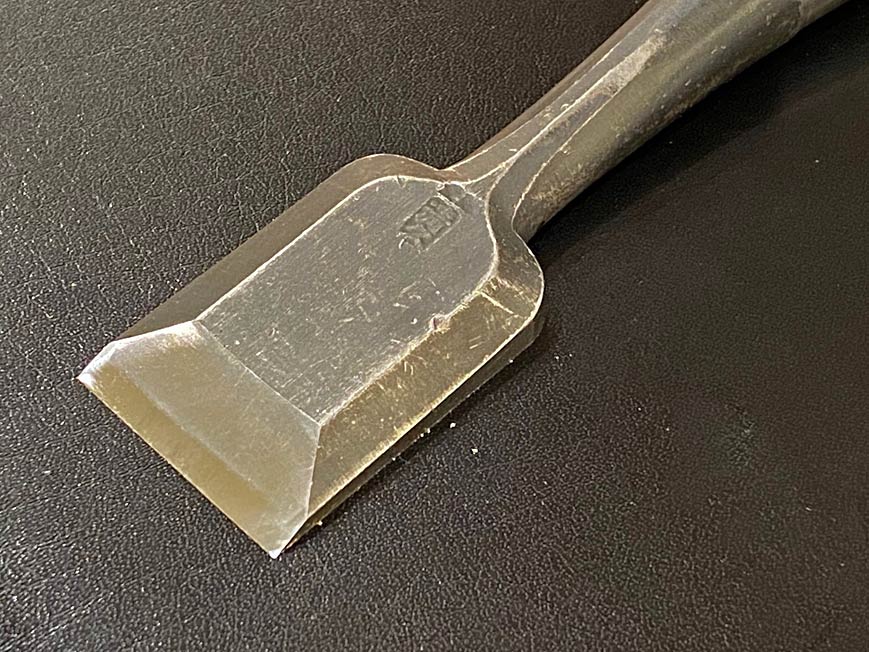
Three Kiyohisa oire nomi (6mm, 24mm and 30mm): US White Oak, Japanese White Oak, and Japanese Red Oak ...

I am happy with the new addition.
Regards from Perth
DerekVisit www.inthewoodshop.com for tutorials on constructing handtools, handtool reviews, and my trials and tribulations with furniture builds.
-
23rd January 2021 04:27 AM # ADSGoogle Adsense Advertisement
- Join Date
- Always
- Location
- Advertising world
- Posts
- Many
-
23rd January 2021, 04:34 AM #2
 SENIOR MEMBER
SENIOR MEMBER











- Join Date
- Dec 2012
- Location
- Australia
- Posts
- 684

Nice work! I was give a tataki nomi blade, ferrule and hoop and made a simple handle just using a piece of Quince tree branch which worked very well. Something about fruit tree timbers seems to work well for chisel/hammer handles.
The quest for Kiyohisa continues!
-
23rd January 2021, 09:29 AM #3

Thanks Derek for such a comprehensive pictorial description. The chisel came up really well. Is there a preference between JP White Oak and Red Oak? If so what is the reason?
Regards
PaulBushmiller;
"Power tends to corrupt. Absolute power corrupts, absolutely!"
-
23rd January 2021, 12:01 PM #4

Paul, I believe that Japanese Red Oak is tougher.
Stu had this to say, on his blog in 2010 ...
Regards from Perth
Derek
Most Japanese chisels are supplied, by default, with Japanese red oak handles, aka; Akagashi (Quercus acuta Thunb), which quite literally means ‘red oak’. It may well be the perfect chisel handle wood being tough, durable, strong and with enough flexibility that it will survive for a goodly time, regardless of the punishment dealt to it as it’s calling in life as a chisel handle.
Japanese red oak is not the same as ‘red oak’ found in other parts of the world however. The Japanese variety is ‘durable’, in that moisture does not adversely affect the same way that North American/European ‘red’ oak is affected. The reason for this is because the grain in the wood is ‘sealed’, where regular red oak has open vessels that allow moisture to readily travel into the wood and cause damage.
Suffice to say, Japanese red oak is tough stuff. Red oak from Korea and China is, for all intents and purposes very similar and displays similar properties, so much so that they are largely interchangeable.
A common option for Japanese chisels is Japanese white oak, aka; Shiragashi (), which again literally translates as ‘white oak’. Japanese white oak is not as strong as red oak, but displays increased flexibility and a propensity to ‘spring back’ after being pushed beyond its limits. This wood is most commonly seen in Japanese planes, where the unique ability of white oak to spring back (European/American white oaks also display this talent) means that a blade will not permanently deform the plane bed, and allows the blade to be removed and replaced repeatedly, without becoming loose.
Lesser quality Japanese white oak is a little less expensive, and is often found on lower grade chisels. However, premium grade white oak is also found on very high grade chisels, offering a softer transmission of force between hammer and blade edge, reducing the chance of edge damage due to shocks.
The highest grade white oak handles will also have the core of the wood running up the middle of the handle, making sure there is zero grain run out through the entire handle, reducing the chance that the handle will split in use to an extent that it might be considered impossible without breaking something else first.
Moving away from the oaks, the next most common handle material is visually identified by its light colour and smooth texture. These handles may be one of two different, but similarly behaving woods identified as ‘Gumi’ or ‘Japanese boxwood’.
The separation of these two woods is less by appearance and performance and more by geography. Boxwood is most commonly found on chisels manufactured in the east of Japan, Gumi is more commonly found in the west of Japan.
Whichever wood is being used, there are some important attributes that make gumi/boxwood the premiere chisel handle material for chisels that will be struck in use. They are ‘softer’ and have an elasticity that transmit the blow from the hammer in a gentler manner and are said to have a good ‘voice’ communicating what’s happening at the edge better than any other wood.
These woods are difficult to find in pieces large enough to make long paring chisels or shorter but heavy duty striking chisels, but the fact that they give a cushioned ‘hit’ makes them very popular for most regular chisels and lighter weight chisels that the user intends to give a hammer tap to frequently.
It is also said that once you use Gumi, you never go back to any other handle material.
Another commonly found handle material is ebony, usually in the form of Macassar ebony with its streaky appearance, offers visual interest to an otherwise potentially bland tool.
And that’s about the size of it really; the popularity of ebony is because it looks nice. The reality is that the wood is brittle, and not really well suited to striking chisels. The brittleness should restrict it to hand pushed chisels only, but it still finds itself on striking chisels where often the race between a snapped handle or a shattered edge results in a mutually destructive draw. However, with light taps delivered from a mallet or lightweight hammer, and consideration given to the fact that ebony is brittle, these handles can offer incredibly long life, and look good whilst doing it.
Rosewood is rarely found in this day in age, but offers similar performance to ebony being hard and absorbing little of a hammer blow, but adds significant resilience that prevents it from cracking in the same way that ebony is prone to do. Usually reserved for the very best chisels, and not likely to be abused because of this, rosewood handles might not ever need replacing.
Of all the handles fitted to Japanese chisels, the above are by far the most common, descending from the most popular to the less commonly found.
Almost any other wood used is chosen for visual interest, often with only secondary consideration to how it will perform as a chisel handle.
And that’s about it with regard to handle material for Japanese chisels. Aside from the appearance, there is a time tested reason for the wood used and the feel and action of the chisel can be tuned to what the ultimate user desires.
Did you only think it was a chunk of wood?
I hope that takes care of the dilemma of choosing a handle for your chisels. Myself, I like meat and potatoes and don’t stray from plain old red oak.
Stu.
 TOOLS.
TOOLS.
«RECENT POSTS - A middle of the ‘process’ update.
- Some very important information.
- Some not very good news.
- Hello. Long time no see.
- Upcoming event; Miki Kaji-Desse.
- When is it?
- Where does the time go?
- What happened to August?
- ‘Back Bevels’ expanded…
- Why I put a ‘back bevel’ on plane blades…
- A few gouges to look at.
- Ouchi oire-nomi x 480
- Will you take them in a box?
- Road Trip; Ouchi chisels.
- End-o-the-month update.
- New stuff, not cheap stuff…
- Import duties?
- Some more new chisels…
- Here be dragons…
- Going 12 rounds?
BLOGROLL
Links to places.
METAVisit www.inthewoodshop.com for tutorials on constructing handtools, handtool reviews, and my trials and tribulations with furniture builds.
-
23rd January 2021, 01:21 PM #5

Thanks Derek
That said it all. I have dealt with Stu in the past, when purchasing sharpening stones. I gather he is no longer trading, but I do not know for what reason.
Regards
PaulBushmiller;
"Power tends to corrupt. Absolute power corrupts, absolutely!"
-
24th January 2021, 03:35 AM #6
 SENIOR MEMBER
SENIOR MEMBER











- Join Date
- Dec 2011
- Location
- SC, USA
- Posts
- 612

Derek, thanks for posting this. It's a super useful tutorial, and I appreciate the amount of time and work you put into making it. It's not easy to do all the camera work and setup for this stuff, as well as writing and editing.
A couple comments... I use American Red Oak for tool handles, including chisel handles and it works fine. I have a suspicion the reasons it's not commonly used are twofold:
1. Tannins in the wood can stain your hands and turn steel tools black. They can also stain your work if you get it sweaty and then put your hand on your work or on a steel tool. Ask me how I know....
2. There are a million other woods locally available, such as Ash, Hickory, Maple, Hornbeam, Beech, Box, and so forth, which don't have tannins that will stain your hands or work.
On "Cored handles" - aka handles made of branches or saplings that have a core of pith in the center... I worried about this until I noticed that like 90% of my antique English "Cast steel" chisels have cored handles made of branches or saplings. They didn't require the "Made in England" touch mark until after 1889.. "Sheffield" in the touch mark preceded that, and "Cast steel" came even earlier... So let's say in the vicinity of 140 years old... To me, if it held up 140 years already, cored wood isn't a detriment.
Once again, thanks for the work.
Similar Threads
-
Oire-nomi or umeki-nomi for small sizes
By cpolubin in forum JAPANESE HAND TOOLSReplies: 2Last Post: 27th June 2018, 09:16 PM -
New koyamaichis oire-nomi / sharpening.
By M.cedro in forum JAPANESE HAND TOOLSReplies: 9Last Post: 13th May 2015, 09:20 PM -
Ouchi oire-nomi
By M.cedro in forum JAPANESE HAND TOOLSReplies: 6Last Post: 7th March 2015, 08:19 AM -
An Oire Nomi WIP: Part I - Initial review on receipt
By Groggy in forum JAPANESE HAND TOOLSReplies: 13Last Post: 9th August 2007, 01:13 PM



 Thanks:
Thanks:  Likes:
Likes:  Picture(s) thanks:
Picture(s) thanks: 
 Reply With Quote
Reply With Quote